| Columns Retired Columns & Blogs |
Wonder how the 'Spinorama' graphs would look like of this speaker? :-) .......
A couple of years ago, DeVore Fidelity's John DeVore gave me a ride from Brooklyn, where we both live, to Michael Lavorgna's place, in New Jersey. John was delivering a preproduction pair of his Gibbon X loudspeakers for Michael to set up in his then-new listening room, and I'd tagged along to give them a listen (footnote 1). Michael's room and system sounded superb, and I made a mental note that when the Gibbon X went into production, we should review it. But, like all things that are important but not urgent, that idea remained on the back burner; instead, we spilled ink on DeVore's high-efficiency Orangutan models (footnote 2). So when Jim Austin suggested, in summer 2018, that he review the Gibbon X, I readily agreed.
I used DRA Labs' MLSSA system and a calibrated DPA 4006 microphone to measure the Gibbon X's frequency response in the farfield, and an Earthworks QTC-40 mike for the nearfield and in-room responses. The DeVore's specified sensitivity is 91.5dB/2.83V/m; my estimate was slightly lower, at 88.8dB(B)/2.83V/m, this probably due, as you'll see below, to a lack of energy in the presence region. DeVore specifies the Gibbon X's impedance as 8.5 ohms. Fig.1, which shows how the X's impedance and electrical phase vary with frequency, shows that the magnitude drops below 8 ohms only in the low bass, the midrange, and above 10kHz. There are minimum values of a still-high 7.2 ohms at 305Hz and 6.1 ohms at 16kHz, though the impedance also drops to close to 6 ohms in the low bass. The electrical phase angle is generally low, and with its combination of high sensitivity and high impedance, the Gibbon X is relatively easy for an amplifier to drive.
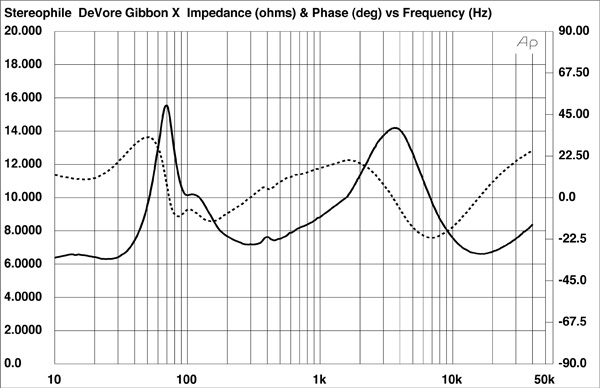
A suspicious-looking bump at 400Hz in the impedance-magnitude trace suggests some sort of enclosure problem at that frequency. However, when I investigated the panels' vibrational behavior with a plastic-tape accelerometer, I found nothing amiss at that frequency. The enclosure seemed mostly inert, and while I found some resonant modes on the front baffle (fig.2) and on the sidewalls below the woofers, these are all low in level and high in both frequency and Quality factor (Q), all of which should mitigate their audibility.
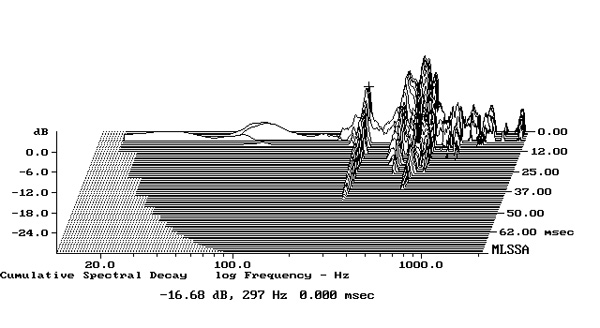
Usually, the impedance-magnitude plot of a reflex loudspeaker has a saddle in the bass, the center frequency of which indicates the tuning of the port(s). However, there's only the slightest hint of a saddle in fig.1, roughly centered on 25Hz. In an e-mail, John DeVore had told me that the Gibbon X shared "a good deal of DNA" with his Silverback Reference loudspeaker, which Michael Fremer reviewed in March 2006. Looking at the Silverback's impedance (footnote 3), it does look as if the Gibbon X's woofer alignment is similar to that of the older speaker. The blue trace in fig.3 shows the output of the woofers, measured in the nearfield: there's a slight minimum-motion notch at 25Hz. The ports' nearfield response (red trace) does have a slight peak at 25Hz, but a stronger one at 80Hz, coincident with the woofers' maximum output. The levels of the woofer and port responses are plotted in the ratios of the square roots of their radiating areas, and it looks as if the ports don't fully extend the Gibbon X's output to their tuning frequency. However, as the ports are close to the speaker's base, their output will be increased by the boundary reinforcement provided by the adjacent floor, as I believe Jim Austin found in his listening.
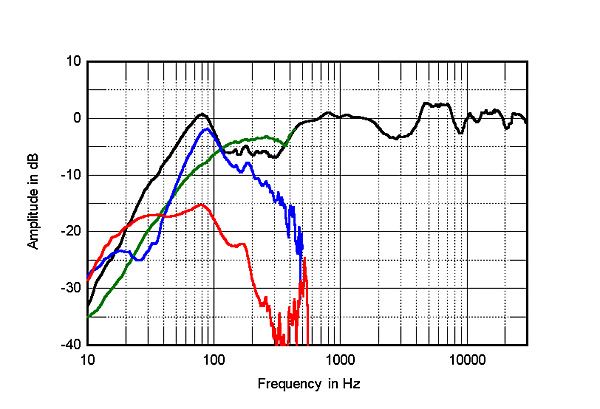
The green trace in fig.3 shows the nearfield response of the midrange drive-unit. Like the Silverback's midrange driver, it extends lower in frequency than you'd expect, with then a second-order rollout below 120Hz. There is also a sharp step upward in its output at 400Hz, which might be due to the absence of any baffle-step compensation in the crossover (footnote 4). The black trace below 300Hz in fig.3 shows the complex sum of the nearfield midrange, woofer, and port responses, taking into account acoustic phase and the different distances of each radiator from a nominal farfield microphone position. As with the Silverback Reference, though to a much lesser degree, the summed output of the midrange and woofer outputs is less than the midrange unit's alone. This suggests that the midrange driver and woofers are out of phase in the region where their outputs overlap, perhaps due to the use of a second-order crossover between the midrange and woofers. I suspect that this behavior lies behind JCA's finding that the Gibbon X sounded lean. (I measured both review samples; they behaved identically.)
Higher in frequency in fig.3, the black trace shows the DeVore's farfield response, averaged across a 30° horizontal window centered on the tweeter axis. (John DeVore told me that, unlike the Silverback Reference, in which the listening axis was level with the midrange driver, the listening axis of the Gibbon X is in-line with the tweeter.) The slight depression between 2 and 4kHz most likely contributes to the slightly-lower-than-specified sensitivity I measured. This presence-region dip is followed by an octave-wide, 2.5dB-high plateau, above which the Gibbon X's top-octave output is flat. When a speaker's response is flat on average, as the Gibbon X's is above 400Hz, the fact that there are peaks will, to some extent, be balanced by the fact that there are also dips, making it more difficult to detect the aberrations by ear. However, when Jim writes that "bright recordings sounded bright," I feel he's referring to the effect of the mid-treble response plateau, especially given the lack of presence-region energy. ("Brightness" is not a function of excess top-octave energy, which will be perceived as "air" or an emphasis of sibilance, neither of which Jim heard.)
The plot of the Gibbon X's horizontal dispersion (fig.4) indicates that the speaker becomes relatively directional between 3 and 8kHz, which will reduce the audibility of its excess on-axis energy in that region. Supporting this idea is the fact that Jim ended up firing the Gibbon Xes straight ahead, which meant that he was listening off axis. In the vertical plane (fig.5), a sharply defined suckout at 6.6kHz develops 5° below the tweeter axis. This suggests that this is the upper crossover frequency, which is an octave and a half higher than usual for a ¾" tweeter. Sitting with your ears higher than the tweeter axis, which is 35" above the floor, will compensate to some extent for the on-axis brightness.
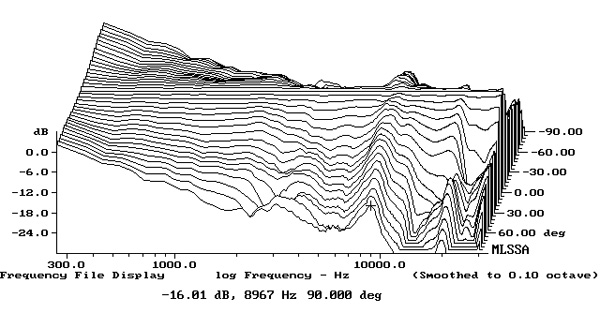
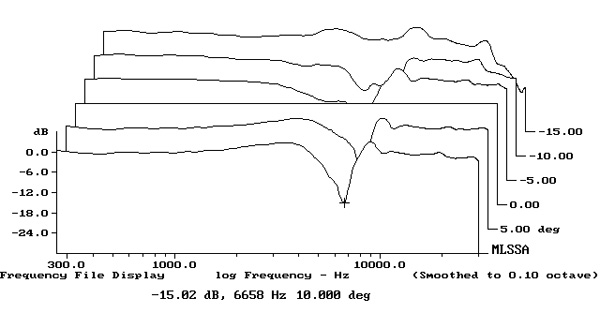
Puzzled by the Gibbon X's quasi-anechoic measurements, I examined its spatially averaged response in my listening room. (I average 20 1/6-octave–smoothed spectra, taken for the left and right speakers individually using a 96kHz sample rate, in a vertical rectangular grid 36" wide by 18" high and centered on the positions of my ears.) The result, with the speakers driven by an Ayre Acoustics EX-8 integrated amplifier, is shown as the red trace in fig.6. The DeVores' lack of energy in the lower midrange is very evident, particularly when compared with the spatially averaged response of the KEF LS50 minimonitors that usually live in my room (blue trace). As you'd expect, the DeVore has more low bass than the KEF and while the Gibbon X's low frequencies sounded very clean, the KEF produces audible second-harmonic distortion below 35Hz or so—its woofer is tiny compared to the Gibbon's twin 9" units. The KEF has more presence-region energy, which is to be expected given the DeVore's lack of energy in the same region in the anechoic measurements. But while the KEF's in-room response slopes smoothly down from 3 to 30kHz in textbook manner, the DeVore has a little too much energy above 10kHz.
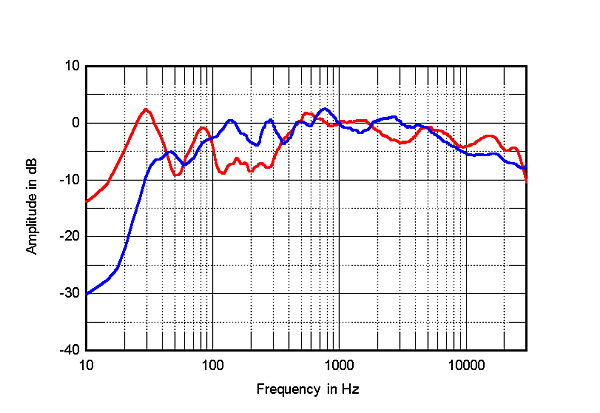
In the time domain, the Gibbon X's step response (fig.7) indicates that all of its drive-units are connected in positive polarity. The sharp spike at 3.7ms is the tweeter's step, followed by that of the midrange driver at 4ms; the slow rise just after 5ms is the woofers' step. The two samples were wired identically, with both woofers and the midrange unit in positive acoustic phase. Other than a ridge of low-level energy at 4.6kHz, the DeVore's cumulative spectral-decay plot (fig.8) was superbly clean.
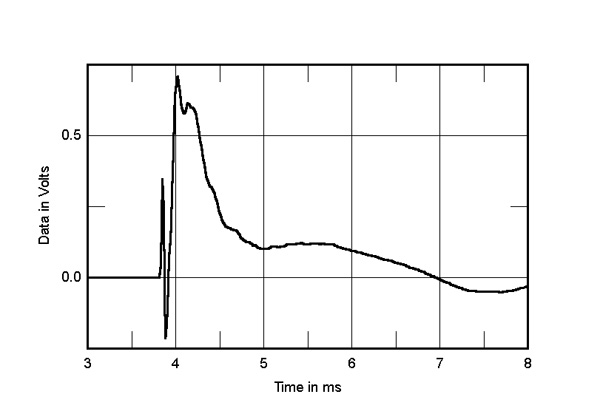
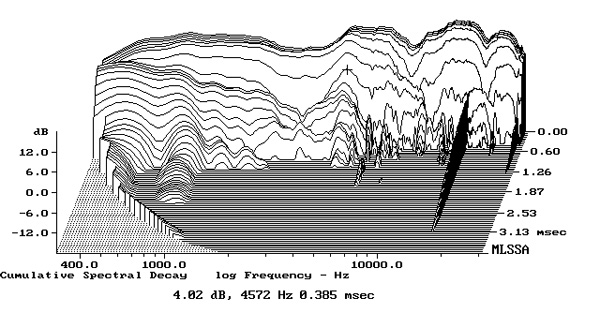
In most respects, the Gibbon X offers good measured performance, with the speaker's departures from a flat on-axis response balanced by its horizontal and vertical dispersion. But, as with DeVore Fidelity's Silverback Reference, I remain puzzled by the choices that were made for the crossover between the midrange and low-frequency drivers, which will make optimizing the speaker positions more difficult than usual.—John Atkinson
Footnote 2: See, for example, here and here.
Footnote 3: See fig.1 here.
Footnote 4: The midrange driver will have reduced output below the frequency at which the baffle width is equal to a half wavelength, which is where a loudspeaker's radiation pattern is changing from omnidirectional or spherical to half-space or hemispherical. This wouldn't usually be a problem, but the extended low-frequency response of the Gibbon X's midrange driver and the speaker's narrow baffle will bring it into play.

Wonder how the 'Spinorama' graphs would look like of this speaker? :-) .......

Some of the info can be gleaned from JA's graphs.

I know ...... It looks somewhat similar to 'speaker C' :-) .........
... or may be, 'weird' frequency response is the proper description :-) .......

Ha! ^^^^ "Nice one centurion. Like it, like it"...;-)

So the Gibbon Xs are at the same price point as the Monitor Audio Platinum 300 II. As well as some Focal speakers. I'd be curious to read about a comparison.

A question for Jim Austin: I see that you own a Leben CS-600 integrated amplifier in the Associated Equipment section of the review. Did you try that amp with the Gibbon X? (I know this is one of the amps that Devore has shown the Gibbon with at shows.) If so, what were your impressions and how did it compare with the Pass and the PS Audio?

God-awful ugly measurements!
(Although, having said that, if everything else measures well, a tasteful presence-region dip is ALWAYS welcome here, after all the over-aggressive sounding speakers I've heard that measure completely flat through that region.)

Lower midrange/Upper bass? You mean the "power range"? BAH! We don't do that these days. It ruins the imaging.

@ John Atkinson: I am a keen reader of your measurement section, but of course I am well aware, that pleasure taken from listening via certain equipment and measurements of same equipment are not exactly the same thing nor fully correlating, but need to be put into relationship i.e. understood (the hard work!).
Thus I really wonder about the somewhat unusual disparity in the relationship of measurement vs percieved sound quality & joy of these speakers. Any findings/comments here?
tx for comment,
cheers
hb

I'm obviously not JA, but maybe this article he wrote will answer your question.
https://www.stereophile.com/content/tale-two-speakers

There is a difference between comparing the sound of 2 well-engineered products, to a speaker like the DeVore, which does not seems to take any engineering into any account. It is hard to imagine why would anyone choose to build such a speaker on purpose.

Lorton wrote: "But, there is always going to be someone who would like what they hear, so what?"
Well, for one thing, you just answered your own previous puzzlement when you wrote:
"It is hard to imagine why would anyone choose to build such a speaker on purpose."
Can you imagine a reason for building such a speaker now? :)

Nope, still can’t.
These are two different subjects (from two separate posts). One has to do with objective assessments (JA measurements), the other is subjective.

Lorton,
"Nope, still can’t."
Really? I find that odd, since the answer is pretty obvious.
You talked about comparing "well engineered" speakers to the Devores and concluded: "It is hard to imagine why would anyone choose to build such a speaker on purpose."
Ok, I guess you could use some help in the imagination department.
You admitted that some people will like the sound of the Devore speakers, right?
That's obviously a reason someone would choose to build such a speaker!
If you are selling speakers, and you come up with a design that some significant number of customers will like...however it measures...THAT'S OBVIOUSLY a rational reason to build such a speaker.
In fact, most speaker designers build the type of speaker THEY LIKE to begin with. John Devore has explained before that he plays a wide range of his favorite music on any of his designs, and they have to pass his own "I like it" test before he considers the job finished. So if a speaker designer likes a certain sound, is aiming for that sound, achieves that sound, and finds a paying audience for that sound...all those amount to good reasons someone would deliberately design such a loudspeaker.
Right?
Maybe *you* wouldn't design a speaker that way, because you have different goals and criteria. But you weren't asking about you; you were wondering why anyone ELSE would design such a speaker. If someone else has different taste, different criteria and goals, then it's entirely explicable and rational they would design to meet those goals.
Is that clear enough I hope?
(Some people seem to have trouble thinking beyond their own goals; if "I" wouldn't do that...it doesn't make sense anyone else has reasons to do it...")

Designing a good speaker, one that will cost $15K, should require a basic understanding of the science involved (and it is not philosophy). For example; what can possibly be the point of using multiple drivers that cancel each other at the output (due to poor XO implementation)??
If you don’t want to hear the full output of your speakers, in the Devore case is anything between 100Hz-500Hz, and 2KHz-4KHz, then just don’t have any drivers playing at these ranges (I bet you some will like that as well). Will be cheaper, and will, at least, look like you meant to do that ;)

I dunno; must be that it achieved the sound he liked. Check the manufacturer's comment and you'll see he's aware of the way his speakers would measure, could have addressed it, but gave his reason why he didn't bother.
Another manufacturer may not have used drivers and crossovers the same way, and hence ended up with a more textbook response like the one that apparently you'd like to see. However, that would change the sound of the speaker, and it clearly wasn't what JD was going for. So it seems more deliberate design choices vs lack of knowledge.

I'll agree with JA's findings:
A couple of years ago, DeVore Fidelity's John DeVore gave me a ride from Brooklyn, where we both live, to Michael Lavorgna's place, in New Jersey. John was delivering a preproduction pair of his Gibbon X loudspeakers for Michael to set up in his then-new listening room, and I'd tagged along to give them a listen (footnote 1). Michael's room and system sounded superb, and I made a mental note that when the Gibbon X went into production, we should review it.
Seems to me that "superb" sounding is a design goal for every manufacturer of hifi gear and John DeVore has clearly hit the mark with the X.
Happy Listening,
Michael Lavorgna
Editor, twitteringmachines.com

May be you (ML) could review the new Elac Navis active, self-powered floor-standers, $4,000/pair, and compare them to Gibbon X? ......... Elac Navis don't need any power-amp(s) :-)...........

...you were to include a number of different amplifiers for the DeVore's since the speakers on their own don't sound like anything ;-)
Cheers,
Michael Lavorgna
Editor, twitteringmachines.com

Ok ....... Don't compare Navis to DeVores ........ You (ML) could just review the Navis floor-standers and tell us what you think :-) .........

...of reviewing 4 pair of active speakers and one all-in-one. This will keep me busy for a while.
Cheers,
Michael Lavorgna
Editor, twitteringmachines.com

Great ...... Active speakers, with or without external EQ/DSP is the future ..... Some active, self-powered subwoofers are already doing it :-) .........

We may have to wait for a while for A.I enabled loudspeakers :-) ........

...most intelligence is artificial.
Ba-da-boom.

Siri, Alexa and Cortana are not sure about Socrates saying that :-) ..........

"A.I will be the best or worst thing for humanity" ......... Elon Musk :-) .........


If we didn't have all these measurements, we would not know about all these deliberate design choices. Thank you again JA :-) .........

Yeah, yeah, measures crap and sound great? You want some oil with those fries?

I spent 2 years hunting for a speaker that sounded great with tube amps. That search ended with the Gibbon X. The most engaging listen in my room, on my system and with my music. Audio magic when paired with an Audio Research REF 75SE. Measurements are useful but hearing is believing.

Wow. Moments after I read this review (and thinking whether to post a reply) I was thinking upon the self-employed businessmen, particularly in the Hi-Fi business and the time-consuming commitment, stress, and responsibility in running said business.
Then I thought, well, at least Devore has friends within Stereophile and Mikey Lazagna plugging away on behalf of Devore loudspeakers.
THEN I thought, wait-a-minute, this is a $15K loudspeaker -BIG money.
If invested it should be done cautiously and wisely. Unassuming consumers should be informed -honestly.
For all the words spilled on the 'X's' subjective SQ impressions (that danced around as opposed to being clear and precise), at least Stereophile demonstrates the responsibility to consider and share some basic test-bench measurements -particularly important with loudspeakers.
And there, the answers lay; this $15K loudspeaker lacks the sophistication that a $15K loudspeaker demands. At that price point, there are several loudspeakers to consider, the finest (to my mind) being the KEF 'Reference 3' ($14K). The Ref-3 is a wonderful-sounding loudspeaker that also happens to be a very, very accurate, low-distortion loudspeaker. Heck, its little brother the 'REF-1' (at $8K/pair) is a fantastic loudspeaker. Both, are thoroughly engineered products. And it shows. I suspect other makes/models in that price range exist as well.
The point being, at the $10K price point, consumers should expect (and get) quality engineering and performance. At $15K-20K, even further refinement, even greater construction quality and accuracy.
Consumers should also expect (and get), honest subjective opinions regarding SQ along with some investigation and insight concerning the loudspeakers construction and engineering sophistication. Neither was offered here.
To make matters worse was finding/reading fellow Stereophile contributor M Lazagna's reply in the comments section.
Waxing poetic about a loudspeaker that measures poorly; far from accurate -or even desirable- casts a huge shadow of suspicion concerning the buddy-buddy relationships that appears to develop between reviewer's/magazines and some manufacturers.
If a business wants to play in the high-end market, they best be bringing some high-end skills -ensuring a competitive product.
This loudspeaker's test-bench results revealed a shockingly uneven (i.e. highly coloured) frequency balance -particularly concerning since today's most basic drive-units (aided by DIY cabinet/x-over rec's) easily offers up accurate, even/linear frequency response -and the fact that linear frequency response is considered so important a design objective.
Today, one must go out-of-their-way to mess up this most basic of loudspeaker performance expectations.
Most bizarre. Most disappointing.
In the end, as always: Caveat emptor.
pj